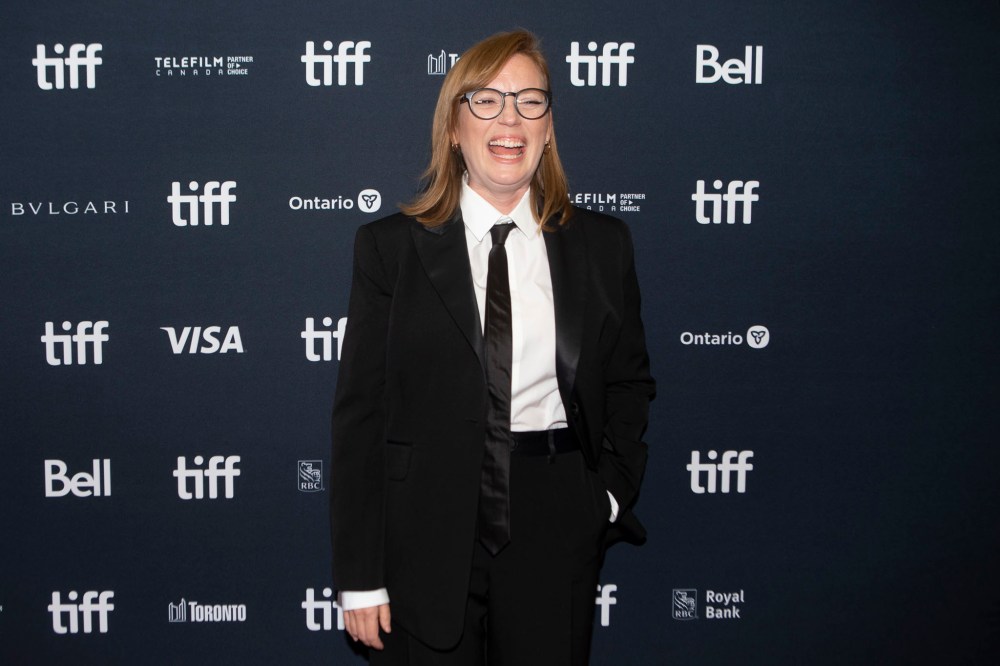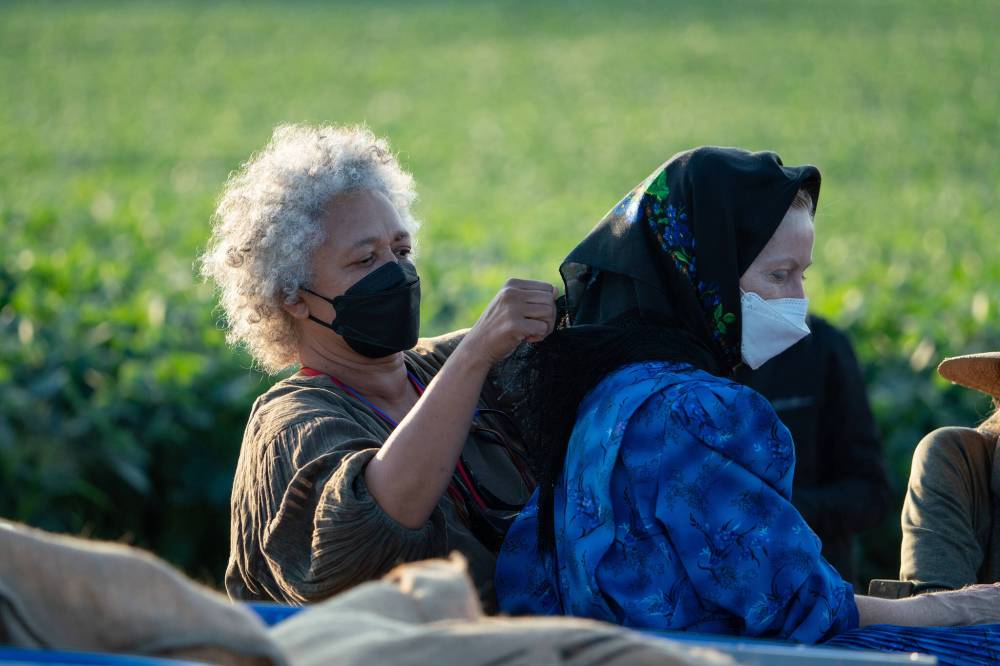Narrative threads Winnipegger’s costumes speak volumes in Women Talking
Read this article for free:
or
Already have an account? Log in here »
To continue reading, please subscribe:
Monthly Digital Subscription
$0 for the first 4 weeks*
- Enjoy unlimited reading on winnipegfreepress.com
- Read the E-Edition, our digital replica newspaper
- Access News Break, our award-winning app
- Play interactive puzzles
*No charge for 4 weeks then price increases to the regular rate of $19.00 plus GST every four weeks. Offer available to new and qualified returning subscribers only. Cancel any time.
Monthly Digital Subscription
$4.75/week*
- Enjoy unlimited reading on winnipegfreepress.com
- Read the E-Edition, our digital replica newspaper
- Access News Break, our award-winning app
- Play interactive puzzles
*Billed as $19 plus GST every four weeks. Cancel any time.
To continue reading, please subscribe:
Add Free Press access to your Brandon Sun subscription for only an additional
$1 for the first 4 weeks*
*Your next subscription payment will increase by $1.00 and you will be charged $16.99 plus GST for four weeks. After four weeks, your payment will increase to $23.99 plus GST every four weeks.
Read unlimited articles for free today:
or
Already have an account? Log in here »
Hey there, time traveller!
This article was published 05/01/2023 (1067 days ago), so information in it may no longer be current.
When the film Women Talking opens here, two Manitoba-raised artists will be vaulted into the bright lights of Hollywood, their names attached to a film destined to draw both Oscar consideration and provincial intrigue.
One of the artists is Miriam Toews.
The other is Quita Alfred.
You’ve likely heard the first name, but if not, a highly abbreviated biography: Toews is the Steinbach-born, Toronto-based author of nine books, three of which made her a finalist for the prestigious Giller Prize, and two of which earned her the Writers’ Trust Award.
MIKAELA MACKENZIE / WINNIPEG FREE PRESS Quita Alfred, wardrobe co-ordinator for Women Talking, met director Sarah Polley while working on The Road to Avonlea.
Since publishing her first novel, Summer of My Amazing Luck, in 1996, Toews has established one of the most significant bodies of work by a modern Manitoban author.
But unless you read film credits closely, the name Quita Alfred is brand new. Alfred, a jubilant woman with an eye for everything, is a costume designer, and with Women Talking — which opens Jan. 13 and is directed by the acclaimed Canadian filmmaker Sarah Polley, starring Frances McDormand, Rooney Mara, Jessie Buckley, Judith Ivey and Claire Foy — Alfred is proving how integral the clothes we wear are to the stories we tell.
Born in Montreal to a Flin Flon mother and a Trinidadian father, Alfred was raised in St. Vital, where she quickly learned the value of fabric. Her grandmother would spread her mouton fur coat on the ground and Alfred would swim in it. Her father wore snappy cotton shirts with wide plaid pants and platform shoes. Her mother dressed tastefully and stylishly, and taught her daughter to sew at the age of four.
“I always thought it was so she could get some peace and quiet on a Saturday afternoon,” says Alfred, wearing a black merino turtleneck sweater, black pants, her lucky necklace and no shoes on a Zoom call in early December from the home she keeps in St. Vital.
Movie preview
Women Talking
Starring Frances McDormand, Ben Whishaw and Jessie Buckley
● Opens Friday, Jan. 13
“I didn’t do the regular ‘Zoom in your jammies’ thing,” she adds. Inspired by legendary Hollywood costume artist Edith Head, Alfred has always insisted on a uniform.
In St. Vital, in the 1970s, that meant a mixture of army surplus, baggy pants, vintage menswear and rainbow toe socks. Very Annie Hall, very M*A*S*H.
“Everybody else was into Suzy Creamcheese jeans and zip-front hoodies. All the young girls in St. Vital look exactly like they did in 1973. So I was the weirdo wearing vintage dresses to dances and flopping around in old men’s shirts.”
Weirdo or not, Alfred’s interest never waned, and soon began to pay off. Even though by her admission she cannot sing well, she became a member of the chorus at Rainbow Stage at the age of 15. In 1982, Alfred was accepted into the theatre production program at what was then known as the Ryerson Polytechnical Institute.
“I was the weirdo wearing vintage dresses to dances and flopping around in old men’s shirts.”–Quita Alfred
Living in Toronto, Alfred was interested in but not passionate about set design or image arts, and continued to ply her trade as a costumer. Needing more of a challenge, she applied to the prestigious Stratford Festival, where she worked in the decorating department in the ever-busy sewing room.
“It taught me more in two weeks than I learned in the previous two years,” she recalls.
Soon, Alfred was working at a Toronto studio called Nigel’s, which did costume work for the grand Mirvish productions as well as the burgeoning Toronto film scene. Working alongside designers such as Martha Mann, Anne Armit and Patricia Boulden, Alfred was in exactly the right place.
In 1990, Mann became the principal designer for a new Canadian scripted program set at the turn of the 20th century, and brought on Alfred as part of her team, designing elaborate, frilly costumes.
The television show was Road to Avonlea. The star was a child actor named Sarah Polley.
Sarah Polley goes back in time in her own memory.
“I remember how warm she was to me,” Polley, wearing a blue button-up shirt and bold, black-rimmed glasses, says of the woman who dressed her on her breakout show.
Talking with Sarah Polley

As a director, which types of stories obsess you, and has that answer changed over time?
I never know what’s going to grab me, but I always seem to be interested in films that have something to do with memory and different versions of the same story, or the way memory informs us or impacts us, and what we do and don’t know about our own experiences.
As a director, which types of stories obsess you, and has that answer changed over time?
I never know what’s going to grab me, but I always seem to be interested in films that have something to do with memory and different versions of the same story, or the way memory informs us or impacts us, and what we do and don’t know about our own experiences.
What about Women Talking grabbed you?
I mean, I just loved how it left me with so many questions. And there was such a sense of a real democratic debate in it, and a sense of taking on not just the political, but the spiritual and philosophical. It forces you to imagine what a different way forward might look like.
Are you the type of director who believes that films have a message?
I think some do, and some sort of talk around things, hopefully in an intelligent and interesting enough way that you end up being able to have a conversation with yourself that you (otherwise) might not have. I think it’s rare for a film to have a really obvious, one-note message without it feeling pedantic, but I think, hopefully, the best films make you interested in the messages you’ve been giving yourself and if they’re right or not.
What do you hope people consider after they see this movie?
I think I just hope they walk away talking and having really in-depth, fruitful conversations that they might not have had before. That would be my main goal.
“And I also remember being struck by how skilled she was — just watching her hands move and the way she assessed things and the way other people in that department related to her. It was clear that she was an incredibly respected person.”
Polley, then 11, really liked Alfred. So much so that she called her up one day to ask the costume designer to go shopping at Kensington Market.
“She was the brightest spark,” Alfred remembers.
But after Alfred left the show, she and Polley went their separate ways. Once Avonlea wrapped up, Polley acted in several acclaimed features, including Atom Egoyan’s The Sweet Hereafter, a story of a small community roiled by a catastrophe.
In 2006, she made her directorial debut with Away From Her, starring legendary actors Julie Christie and Gordon Pinsent, whose career took off on Winnipeg stages in the 1950s. Polley quickly established herself as a dynamic and versatile filmmaker.
Alfred watched her friend from a distance at every turn. She would be lying if she said there weren’t a bit of maternal pride in seeing the little girl she once took shopping becoming such a fully formed artist.
But Alfred — who has worked on such film and TV productions as The Long Kiss Goodnight and American Gods — thought of Polley as a representation of a cheerful past, not the present. Until her phone rang in January 2021.
ASSOCIATED PRESS FILES Director Sarah Polley
Coincidentally, Alfred, who splits time between Toronto and Winnipeg, was back in St. Vital, visiting her parents. On the other line was producer Lyn Lucibello, asking Alfred if she was interested in speaking with Polley about becoming the principal costume designer for Women Talking.
“Let’s just say I was very perplexed,” says Alfred. “I really thought I was being punked.”
But Lucibello was serious, and soon, Alfred and Polley were talking about making a movie together.
“Of course there were tears,” Alfred says.
It was clear from the first meeting, Polley says, that Alfred was right for the job.
“She fights for her crew, she’s decent to people, she understands what people need because she’s played so many roles herself in that department,” says Polley.
About plain dress
Zaley Warkentin is a Winnipeg-based creator and seller of plain dress fashions, selling the clothes on the online marketplace Etsy under the name PrairieQuaker. The Free Press asked Warkentin a few questions to help better understand the meaning of plain dress.
Zaley Warkentin is a Winnipeg-based creator and seller of plain dress fashions, selling the clothes on the online marketplace Etsy under the name PrairieQuaker. The Free Press asked Warkentin a few questions to help better understand the meaning of plain dress.
Some people might think plain dress means there’s no room for expression. Can you explain why that isn’t the case?
I think this depends on how people conceive of self-expression. Within plain dress communities, overt differences or decoration would run contrary to the aim of plain dress. Anything that could be considered “showing off” or vanity is strongly frowned upon.
However there is still room for self-expression within plain dress, most commonly seen in fabric choice (within church guidelines), sleeve and hem construction, stitching, and other small details that aren’t necessarily noticeable outside the community.
The rules or guidelines around dress in plain communities will vary widely depending on which church group you are a part of, and the forms self-expression take within those groups will vary accordingly.
What does plain dress mean to you?
Plain dress is a form of orthopraxy, an outward representation of an inward faith commitment. It is one practical way in which I can live out my faith in day-to-day life.
It reminds me of humility, integrity, and living into our faith daily. It reminds me that I am part of something larger than myself, a community of believers following a particular path.
How does plain dress contribute to the feeling of community?
Dress codes foster a sense of belonging and group identity. They also aim to create a sense of equality within the community, where no one is “better than” their peers. There is a sense of camaraderie among different groups of plain dressers.
– Ben Waldman
“And that was really important to me in terms of building a healthy work environment: that the people we’re going to be working with were going to be deeply understanding of what they did in their craft and how they needed to be treated.”
Alfred had also read the book. Women Talking is a fictionalized account of eight women living on an ultraconservative Mennonite community in Bolivia called the Molotschna colony, where personal and familial relationships are cracked open by startling allegations of rape and sexual assault.
Toews’ book, which is based on an actual case that took place between 2005 and 2009 on Bolivia’s Manitoba colony, was an immediate bestseller, tapping subtly and intelligently into some of the most pressing questions of human existence.
Another element that helped Alfred was her location. “I told Lyn and Sarah, ‘You two know I’m also in the heart of Mennonite country?’” she remembers asking.
“I said you can’t swing a cat and not hit a Mennonite in Winnipeg.”
Hired almost on the spot, Alfred got to work gathering research into plain dress, a form of modest wardrobe favoured by many Mennonite communities.
In his 1986 book, Why Do They Dress Like That, Stephen Scott writes attempts to answer the titular question.
Scott writes that although dress is a minor issue in many religious groups’ total belief system, it “speaks.”
MICHAEL GIBSON / ORION Frances McDormand stars as Scarface Janz, a member of a Mennonite colony in Bolivia, in Women Talking.
“One’s clothing indicates one’s identity and image, whether rock musician or sophisticated businessperson,” he writes. Clothing serves as a reminder, Scott writes, of hierarchy, class, status and commitment to ideals.
To understand plain dress, Alfred drew upon an informal Rolodex. She called a film colleague whose mom lives in Portage la Prairie, who then connected Alfred with a friend in Winkler, who then connected her with various women to chat about the unique garb.
“People in Toronto just don’t understand,” Alfred says with a laugh. “You call your neighbour or your friend or phone the Canadian Tire here and they call their brother-in-law.
“(The people) were interested in helping because in my experience, that is the Mennonite way,” she adds. “My experience of Mennonite culture has always been one of generosity, service and helpfulness.”
Meanwhile, she did extensive research into Mennonite clothing, marked by migration, practicality and community — much like any other group, defined by commitment to togetherness and remembering where they came from.
“My fascination always comes from what people do to make themselves comfortable in the world, how they outwardly express themselves in order to present their true selves to the world or to hide their true selves from the world.”
MICHAEL GIBSON / ORION Quita Alfred makes some costume adjustments on an actor.
In Women Talking, costumes speak loudly. “Quita was constantly looking for ways in which even the fabrics were expressing things about the families, finding subtle ways to delineate them from each other,” Polley says. “My favourite thing is when there’s a mother and daughter and they’re wearing the same dress, basically.”
“Plain” dress is also a slight misnomer, Polley and Alfred say. The term evokes a dreariness, but within the spectrum of modest fashion exist bright colours and patterns. In life, these patterns are dictated by choice and taste, but in the film, the clothing differentiates character types, sometimes serving as a red herring and other times serving as an indication of family lines.
For the Friesens, Alfred was drawn toward blues and purples and more repetitive patterns. For the Loewens, it was greens and golds and browns, with more expressive patterns, swirling and colouring outside the lines.
The Janz family, headed by the matriarchal McDormand, is coloured by hues of rust and terra cotta.
The clothing Alfred and her team designed served as both camouflage and the exact opposite of it: a quiet, yet clear, expression of character that harmonizes with the vision of Polley’s film.
ben.waldman@winnipegfreepress.com

Ben Waldman covers a little bit of everything for the Free Press.
Our newsroom depends on a growing audience of readers to power our journalism. If you are not a paid reader, please consider becoming a subscriber.
Our newsroom depends on its audience of readers to power our journalism. Thank you for your support.
History
Updated on Friday, January 6, 2023 6:10 AM CST: Corrects spelling of Whishaw in factbox
Updated on Friday, January 6, 2023 8:32 AM CST: Updates factbox placement







